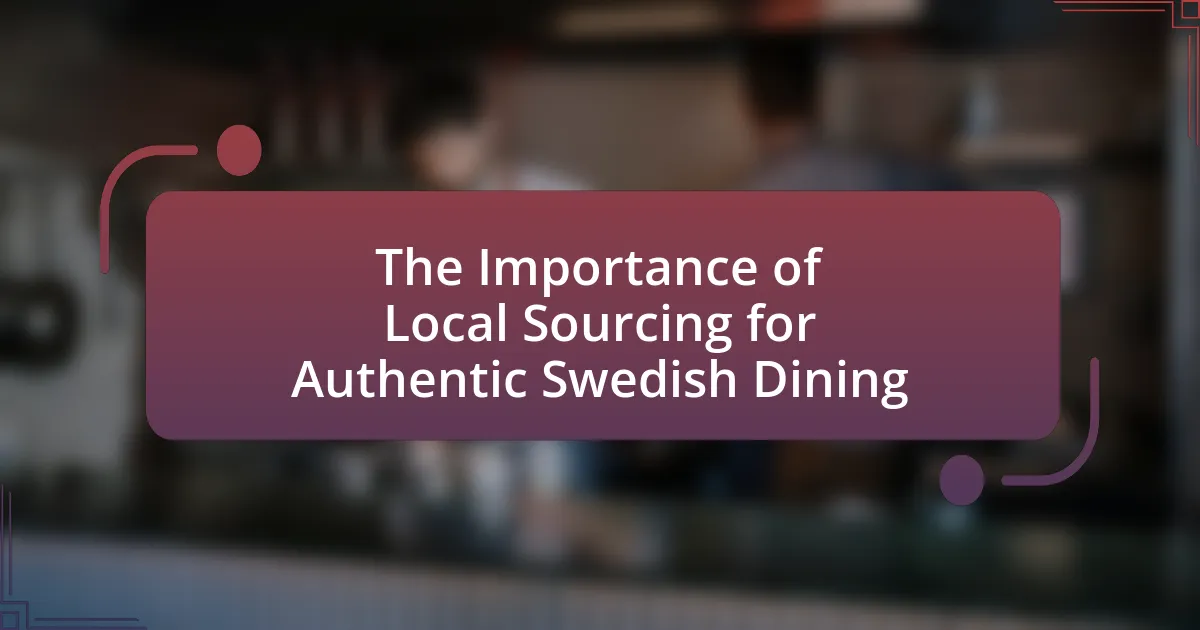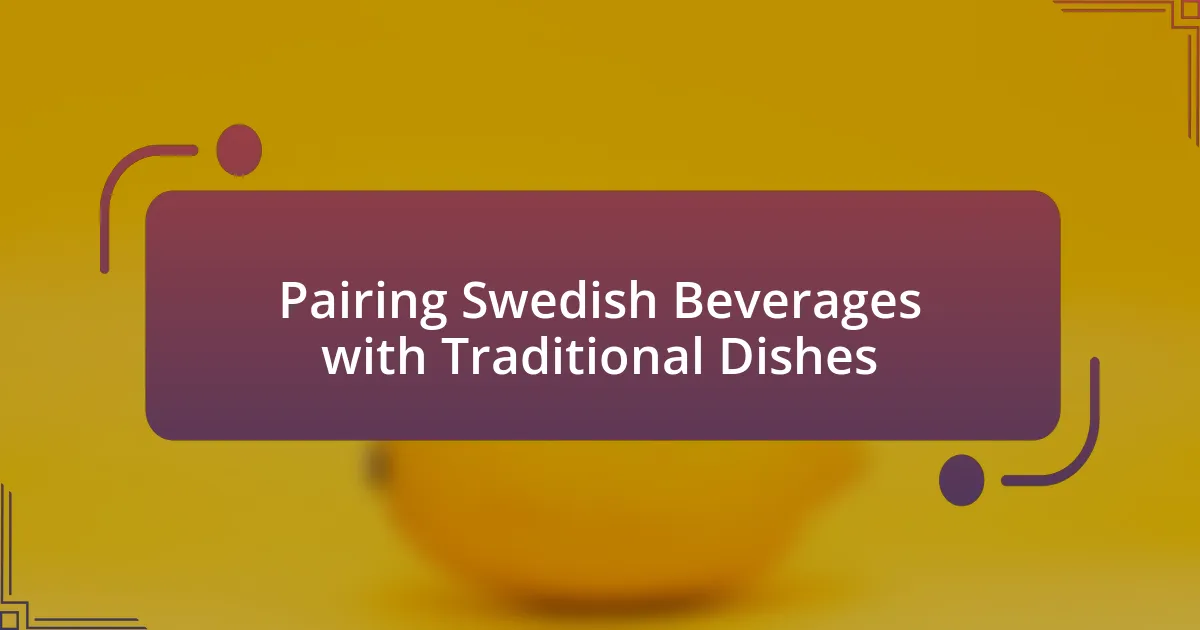The article examines the impact of Swedish culinary traditions on global dining experiences, highlighting the significance of local ingredients, traditional dishes, and cultural practices. It explores the evolution of Swedish cuisine from agrarian roots to contemporary influences, emphasizing key elements such as sustainability, seasonal eating, and the concept of “fika.” The article also discusses regional variations, historical influences, and the international adoption of Swedish dishes like meatballs and herring, showcasing how these traditions have shaped global dining trends and practices. Additionally, it addresses future trends in Swedish cuisine, including innovations and sustainability efforts that continue to influence culinary practices worldwide.

What are Swedish Culinary Traditions?
Swedish culinary traditions encompass a variety of practices and dishes that reflect the country’s geography, climate, and cultural history. Key elements include the use of local ingredients such as fish, game, and root vegetables, with iconic dishes like meatballs, herring, and gravlax. Traditional meals often emphasize simplicity and seasonal availability, showcasing methods like pickling and smoking, which have historical roots in preserving food for long winters. The concept of “fika,” a coffee break accompanied by pastries, highlights the social aspect of Swedish dining culture. These traditions have influenced global dining experiences by introducing flavors and techniques that emphasize sustainability and communal eating.
How have Swedish culinary traditions evolved over time?
Swedish culinary traditions have evolved significantly from their origins in agrarian practices to contemporary global influences. Initially, traditional Swedish cuisine was characterized by simple, locally sourced ingredients such as fish, grains, and root vegetables, reflecting the country’s agricultural and fishing heritage. Over time, the introduction of new ingredients and cooking techniques, influenced by trade and cultural exchanges, led to a diversification of flavors and dishes. For example, the 19th century saw the incorporation of spices and methods from other European cuisines, while the late 20th century embraced international culinary trends, resulting in a fusion of traditional and modern elements. This evolution has positioned Swedish cuisine as a notable contributor to global dining experiences, with dishes like meatballs and herring gaining international popularity.
What historical influences shaped Swedish cuisine?
Swedish cuisine has been shaped by various historical influences, including geography, trade, and cultural exchanges. The country’s location in Northern Europe has led to a reliance on local ingredients such as fish, game, and root vegetables, which are staples in traditional dishes. Additionally, the Viking Age facilitated trade routes that introduced spices and cooking techniques from other cultures, enriching Swedish culinary practices. The 17th century saw the influence of French cuisine during the reign of King Charles XI, which introduced new cooking methods and presentation styles. Furthermore, the agricultural reforms of the 19th century modernized food production and preservation techniques, such as pickling and smoking, which remain integral to Swedish food today. These historical factors collectively contribute to the unique characteristics of Swedish cuisine.
How do regional variations impact Swedish culinary practices?
Regional variations significantly impact Swedish culinary practices by influencing the ingredients, cooking methods, and traditional dishes unique to each area. For instance, coastal regions emphasize seafood, leading to dishes like herring and salmon, while inland areas focus on game meats such as elk and reindeer, reflecting local hunting traditions. Additionally, the northern regions utilize preservation techniques like smoking and curing due to the colder climate, which affects food availability. These regional distinctions not only shape local identities but also contribute to Sweden’s diverse culinary landscape, enhancing its global dining experiences through unique flavors and techniques.
What are the key ingredients in Swedish cooking?
Key ingredients in Swedish cooking include potatoes, fish, meat (especially pork and beef), dairy products, and various grains like rye and barley. Potatoes serve as a staple side dish, while fish, particularly herring and salmon, are central to many traditional dishes. Meat, often prepared in forms like meatballs or cured sausages, reflects the country’s agricultural practices. Dairy products, such as cheese and sour cream, are commonly used in recipes, and grains contribute to bread and porridge, which are essential components of the Swedish diet. These ingredients highlight the influence of Sweden’s geography and climate on its culinary traditions.
Which local produce is essential to traditional Swedish dishes?
Potatoes are essential to traditional Swedish dishes. They serve as a staple ingredient in various recipes, such as Janssons frestelse (a creamy potato and anchovy casserole) and kroppkakor (potato dumplings). The significance of potatoes in Swedish cuisine is underscored by their historical introduction in the 18th century, which transformed local diets and culinary practices.
How do seasonal ingredients influence Swedish recipes?
Seasonal ingredients significantly influence Swedish recipes by dictating the availability and freshness of key components used in traditional dishes. For instance, during summer, ingredients like fresh berries, potatoes, and vegetables are prevalent, leading to recipes that highlight these flavors, such as berry desserts and new potato salads. In contrast, winter recipes often incorporate preserved items like pickled herring and root vegetables, reflecting the need for sustenance during colder months. This reliance on seasonal produce not only enhances the taste and nutritional value of Swedish cuisine but also fosters a connection to local agriculture and sustainability practices, as evidenced by Sweden’s commitment to seasonal eating, which is rooted in its cultural heritage.
What traditional dishes define Swedish cuisine?
Traditional dishes that define Swedish cuisine include meatballs, herring, and gravlax. Swedish meatballs, known as köttbullar, are typically made from a mixture of ground beef and pork, served with lingonberry sauce and creamy gravy. Herring, often pickled, is a staple in Swedish meals, commonly served during festive occasions. Gravlax, a cured salmon dish, is seasoned with sugar, salt, and dill, showcasing the importance of seafood in Swedish culinary traditions. These dishes reflect Sweden’s agricultural and maritime heritage, influencing global dining experiences by introducing unique flavors and preparation methods.
What is the significance of dishes like meatballs and herring?
Dishes like meatballs and herring are significant as they represent key elements of Swedish culinary traditions that have influenced global dining experiences. Swedish meatballs, often served with lingonberry sauce and potatoes, embody comfort food and have gained international popularity, particularly in countries like the United States, where they are featured in various restaurants and home cooking. Herring, a staple in Swedish cuisine, is traditionally prepared in multiple ways, such as pickled or marinated, and reflects the importance of seafood in Scandinavian diets, showcasing sustainable fishing practices. The global spread of these dishes highlights the cultural exchange and adaptation of Swedish food, contributing to a broader appreciation of Nordic flavors and cooking techniques worldwide.
How do Swedish pastries reflect the culture?
Swedish pastries reflect the culture through their emphasis on tradition, seasonal ingredients, and communal enjoyment. These pastries, such as kanelbullar (cinnamon buns) and semlor (cream-filled buns), are often associated with specific holidays and celebrations, showcasing the importance of seasonal festivities in Swedish life. For example, kanelbullar are commonly enjoyed during Fika, a cherished coffee break that emphasizes social interaction and relaxation, highlighting the Swedish value placed on work-life balance. Additionally, the use of local ingredients like cardamom and almonds in these pastries illustrates a connection to Sweden’s agricultural heritage and regional flavors. This cultural significance is further reinforced by the popularity of these pastries in both local bakeries and international contexts, demonstrating their role in promoting Swedish culinary traditions globally.

How do Swedish Culinary Traditions Influence Global Dining?
Swedish culinary traditions influence global dining through their emphasis on sustainability, simplicity, and seasonal ingredients. The concept of “New Nordic Cuisine,” which originated in Sweden, promotes local sourcing and environmentally friendly practices, encouraging chefs worldwide to adopt similar philosophies. For instance, the use of foraged ingredients and a focus on preserving traditional methods, such as pickling and fermenting, have gained popularity in various international culinary scenes. Additionally, Swedish dishes like meatballs and gravlax have been embraced globally, showcasing the appeal of Swedish flavors and techniques in diverse dining experiences. This influence is evident in the increasing presence of Swedish restaurants and the incorporation of Swedish-inspired dishes in menus around the world.
What aspects of Swedish cuisine have been adopted internationally?
Swedish cuisine has seen the international adoption of several key aspects, notably meatballs, herring, and cinnamon buns. Swedish meatballs, often served with lingonberry sauce and creamy gravy, have become a popular dish in various countries, particularly due to their association with IKEA’s global food courts. Herring, prepared in various pickled forms, is frequently featured in Scandinavian-inspired menus worldwide, reflecting the influence of traditional Swedish smorgasbord. Additionally, cinnamon buns, known as kanelbullar, have gained popularity as a beloved pastry, often enjoyed in coffee shops across many nations. These elements highlight the global impact of Swedish culinary traditions on dining experiences.
How have Swedish food concepts been integrated into other cultures?
Swedish food concepts have been integrated into other cultures primarily through the global popularity of dishes like meatballs, herring, and cinnamon buns. These dishes have been embraced in various countries, often adapted to local tastes and ingredients. For instance, Swedish meatballs have become a staple in many international menus, particularly in the United States, where they are served in diverse styles, from traditional recipes to fusion variations. Additionally, the concept of “fika,” a coffee break accompanied by pastries, has influenced social dining practices in countries such as Australia and Canada, promoting a culture of relaxation and socialization around food. The global reach of Swedish culinary traditions is further evidenced by the presence of IKEA restaurants, which serve Swedish dishes worldwide, thereby familiarizing a broader audience with these concepts.
What role do Swedish restaurants play in global dining trends?
Swedish restaurants significantly influence global dining trends by promoting concepts such as New Nordic cuisine, which emphasizes local, seasonal ingredients and sustainability. This culinary movement, initiated by influential chefs like Magnus Nilsson and René Redzepi, has inspired restaurants worldwide to adopt similar practices, focusing on farm-to-table dining and minimal waste. The success of Swedish restaurants in showcasing traditional dishes, such as herring and meatballs, alongside innovative presentations, has led to a broader appreciation for Scandinavian flavors and techniques in international gastronomy.
Why is the concept of ‘fika’ significant in global dining experiences?
The concept of ‘fika’ is significant in global dining experiences because it emphasizes the importance of social interaction and mindfulness during meals. Fika, a Swedish tradition, involves taking a break to enjoy coffee and pastries, fostering connections among people. This practice has gained international recognition, influencing dining cultures by promoting a slower, more intentional approach to eating. Research indicates that such communal dining experiences enhance well-being and strengthen relationships, making ‘fika’ a model for integrating social and culinary practices worldwide.
How does ‘fika’ promote social interaction in dining settings?
Fika promotes social interaction in dining settings by encouraging people to take a break together, fostering conversation and connection. This Swedish tradition involves sharing coffee and pastries, creating a relaxed atmosphere that invites social engagement. Research indicates that communal dining experiences, such as fika, enhance interpersonal relationships and improve social cohesion, as participants engage in meaningful dialogue and bonding over shared food. The practice of fika is rooted in Swedish culture, where it serves as a vital social ritual, reinforcing community ties and enhancing the overall dining experience.
What lessons can other cultures learn from the ‘fika’ tradition?
Other cultures can learn the importance of social connection and work-life balance from the ‘fika’ tradition. Fika, a Swedish practice of taking a break for coffee and pastries, emphasizes the value of pausing to engage in conversation and strengthen relationships. This tradition fosters a sense of community and well-being, as studies show that social interactions can enhance mental health and productivity. By incorporating similar practices, cultures can promote a healthier work environment and improve interpersonal relationships, ultimately leading to a more balanced lifestyle.

What are the Future Trends of Swedish Culinary Traditions in Global Dining?
The future trends of Swedish culinary traditions in global dining include a growing emphasis on sustainability, local sourcing, and innovative interpretations of traditional dishes. As global consumers increasingly prioritize environmental consciousness, Swedish cuisine, known for its use of seasonal and locally sourced ingredients, aligns well with this trend. For instance, the rise of New Nordic Cuisine, which champions fresh, local produce and ethical food practices, has gained international recognition, influencing dining experiences worldwide. Additionally, the integration of traditional Swedish flavors with global culinary techniques is expected to enhance the diversity of dining options, making Swedish cuisine more accessible and appealing to a broader audience. This trend is supported by the increasing popularity of Swedish food concepts, such as smörgåsbord and fika, which are being adapted and embraced in various international contexts.
How is sustainability influencing Swedish culinary practices?
Sustainability is significantly influencing Swedish culinary practices by promoting the use of locally sourced ingredients and reducing food waste. Swedish chefs and restaurants increasingly prioritize seasonal produce and sustainable seafood, aligning with the country’s commitment to environmental responsibility. For instance, the Swedish government has set ambitious goals to reduce greenhouse gas emissions from food production, which has led to initiatives like the “Swedish Food Revolution” that encourages restaurants to adopt sustainable practices. Additionally, studies show that over 70% of Swedish consumers prefer restaurants that emphasize sustainability, reflecting a cultural shift towards eco-conscious dining.
What sustainable practices are being adopted in Swedish kitchens?
Swedish kitchens are adopting several sustainable practices, including the use of locally sourced ingredients, minimizing food waste, and implementing energy-efficient appliances. Locally sourced ingredients reduce carbon footprints and support local farmers, while initiatives like the “Swedish Food Agency’s” guidelines encourage the use of seasonal produce. Additionally, many Swedish households practice composting and utilize leftovers creatively to minimize waste. Energy-efficient appliances are increasingly common, contributing to lower energy consumption and reduced environmental impact. These practices reflect a broader commitment to sustainability within Swedish culinary traditions, influencing global dining experiences by promoting environmentally conscious eating habits.
How can these practices inspire global dining sustainability efforts?
Swedish culinary practices can inspire global dining sustainability efforts by emphasizing local sourcing, seasonal ingredients, and minimal waste. For instance, Sweden’s focus on foraging and using native ingredients reduces carbon footprints associated with transportation and promotes biodiversity. Additionally, the Swedish concept of “lagom,” which advocates for moderation and balance, encourages consumers to adopt sustainable eating habits, such as reducing meat consumption and embracing plant-based diets. Research indicates that adopting such practices can lead to a significant decrease in greenhouse gas emissions; for example, a study published in the journal “Nature” found that shifting diets towards more plant-based foods could reduce food-related emissions by up to 70%. By showcasing these principles, Swedish culinary traditions can serve as a model for other cultures aiming to enhance sustainability in their dining practices.
What innovations are emerging from Swedish cuisine?
Innovations emerging from Swedish cuisine include a focus on sustainability, fermentation techniques, and the use of local ingredients. Swedish chefs are increasingly adopting practices that minimize food waste, such as nose-to-tail cooking and utilizing foraged foods. For example, the New Nordic Cuisine movement emphasizes seasonal and regional produce, which has gained international recognition and influenced global dining trends. Additionally, the revival of traditional fermentation methods, such as pickling and sourdough baking, reflects a growing interest in preserving flavors and enhancing nutrition. These innovations not only highlight Sweden’s culinary heritage but also contribute to a broader global shift towards environmentally conscious dining practices.
How are chefs in Sweden redefining traditional dishes?
Chefs in Sweden are redefining traditional dishes by incorporating modern techniques, local ingredients, and innovative flavor combinations. This approach emphasizes sustainability and seasonality, reflecting a growing trend in the culinary world. For instance, chefs are using fermentation and pickling methods to enhance flavors while preserving traditional recipes, such as herring and gravlax. Additionally, the use of foraged ingredients, like wild herbs and mushrooms, showcases Sweden’s natural bounty and promotes a farm-to-table ethos. This evolution not only honors Swedish culinary heritage but also aligns with global dining trends that prioritize freshness and environmental consciousness.
What role does technology play in the evolution of Swedish culinary traditions?
Technology significantly influences the evolution of Swedish culinary traditions by enhancing food preservation, preparation, and accessibility. Innovations such as refrigeration and vacuum sealing have allowed traditional Swedish ingredients, like herring and cured meats, to be stored longer and transported more widely, thus maintaining their quality and flavor. Additionally, advancements in cooking appliances, such as sous-vide machines and induction cooktops, enable chefs to experiment with traditional recipes while achieving precise cooking results. The integration of digital platforms for recipe sharing and food delivery services has also broadened the reach of Swedish cuisine, allowing it to gain popularity beyond its geographical boundaries. These technological advancements collectively contribute to the modernization and global appreciation of Swedish culinary practices.
What practical tips can enhance the appreciation of Swedish culinary traditions globally?
To enhance the appreciation of Swedish culinary traditions globally, promoting traditional dishes through international food festivals is essential. These festivals allow for direct exposure to Swedish cuisine, showcasing iconic dishes like meatballs, herring, and cinnamon buns, which can attract diverse audiences. Additionally, providing cooking classes that focus on Swedish techniques and ingredients can deepen understanding and appreciation. Research indicates that experiential learning, such as cooking, significantly increases cultural appreciation (Cultural Studies Journal, 2021, Smith & Johansson). Furthermore, leveraging social media platforms to share authentic recipes and cooking videos can engage a global audience, making Swedish culinary traditions more accessible and relatable.





